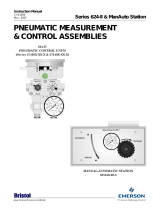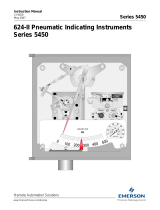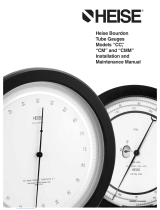
PKP Prozessmesstechnik GmbH
Borsigstrasse 24
D-65205 Wiesbaden-Nordenstadt
Tel: 06122 / 7055 - 0
Fax: 06122 / 7055 – 50
Operating Instructions
PDS02
Differential pressure gauge for gasses with membrane
measuring system

INSTRUCTION LEAFLET FOR PRESSURE GAUGES
WARNING:
Incorrect use of pressure gauges can cause damage and injuries. Under this Directive, the user must ensure that pressure gauges are installed
and used in such a way that pressure-related hazards are eliminated to a maximum extent.
Before starting installation, follow the recommendations of standard EN 837-2:
Check that the pressure gauge, designed in compliance with standard EN 837-1/3, is suitable for the planned use in terms of:
▪ Operating pressure (OP) ▪ Type of mounting
▪ Operating temperature (OT) ▪ Compatibility of materials in contact with the fluid to be measured
▪ Safety level of the pressure gauge ▪ Environmental conditions, vibrations, shocks, pulses, ambient atmosphere
▪ Connection interface ▪ Check that the pressure gauge is compatible with the surrounding atmosphere
USE IN AN OXYGEN CIRCUIT
Check that the pressure gauge is designed for such an application. The dial must have the word OXYGEN printed in red and the international
symbol “oil-free” (a crossed-out burette). The pressure gauge must not have been in contact with oil or grease that is incompatible with oxygen:
RISK OF EXPLOSION!
Mounting
A pressure gauge must be mounted in compliance with standard practice.
We advise to mount with an isolation valve.
The user must check that the connections are perfectly sealed by using suitable seals that are compatible with the fluid to be measured.
Use a correctly sized spanner to tighten connections. NEVER TWIST THE CASE IN ORDER TO TIGHTEN CONNECTIONS.
Comply with the instructions given on the device when putting it into service.
For pressure gauges fitted with a rear blow-out disc for protection against overpressure, ensure that there is a gap of at least 10 mm
between the rear panel of the casing and the panel immediately next to it.
Likewise, for this type of rear blow-out disc and a casing filled with damping fluid, do not remove the disc from its location.
Only re-use a pressure gauge if the medium is the same as for its first use.
USE
Warning: The operating conditions must be such that the device can be used safely.
THE PRESSURE GAUGE MUST NOT BE SUBJECTED TO:
Mechanical shocks: if there is a risk install it at a distance with a hose connection.
Vibrations: if there is a risk install it at a distance with a hose connection or use a liquid filled pressure gauge.
Pressure pulses: if there is a risk mount a pulsation damper.
Warning: pressure pulses cause a considerable shortening of the operating life of pressure gauges.
Pressures greater than operating pressures (OP). Otherwise use a pressure relief valve.
Temperatures greater or less than operating temperatures (OT). If there is a risk use a siphon mount or mount with hose connection to
respect the temperature at the pressure gauge.
NOTE:
Failure to observe the conditions above may reduce pressure gauge safety. In such cases contact us.
DISASSEMBLY
During disassembly, check that the pressure gauge is no longer under pressure. As a precaution, disassemble it slowly.
Check that the temperature of the pressure gauge body is not sufficient to cause burning.
Check that residues of the product present in the tube and block of the pressure gauge are not dangerous for the operator and the
environment.
MAINTENANCE
The general safety of a facility often depends on the reliability of indications on the pressure gauges installed in the facility.
Any pressure gauge that seems to be giving false readings must be removed immediately, then tested. If the tests prove it is unreliable, it
must be replaced with a new device.
Periodic verifications should be carried out to check the accuracy of pressure gauges.
Any pressure gauge considered to have been subjected to abnormal conditions of use (e.g. fire, wrong fluid, blows, etc.) must not be used.
MAINTENANCE, VERIFICATION OR RECALIBRATION MUST BE CARRIED OUT BY
PERSONNEL APPROVED BY THE CONSTRUCTOR AND USING SUITABLE EQUIPMENT.
IMPORTANT
The instructions in this leaflet must be strictly followed.
The manufacturer declines all responsibility for any direct or indirect damage to property or persons as well as for the consequence, for
example, of lost production resulting from failure to observe the instructions in this leaflet.

PKP Process Instruments Inc.
10 Brent Drive · Hudson, MA 01749
S +1-978-212-0006 · T +1-978-568-0060
Email: [email protected] · Internet: www.pkp.eu
PKP Prozessmesstechnik GmbH
Borsigstraße 24 · D-65205 Wiesbaden
S +49 (0) 6122-7055-0 · T +49 (0) 6122-7055-50
Email: [email protected] · Internet: www.pkp.de
Pressure Measurement and Monitoring
Economical pressure gauge
with diaphragm sensing system
for measuring relative and
differential pressures
• Fornon-corrosivegases
• Availablemeasuringranges:
from 0–60 Pa to 0–30 kPa
• Rugged,heavy-dutycastaluminum
housing
• Forpanelmountingorsurfacemounting
PDS02
Description:
Model PDS02 pressure gauges can be used to measure
positive, negative or differential pressures. The devices are
enclosed in a rugged aluminum housing and have two sets
of two pressure inlets – one set on the side, and one set on
the back – which can be used as needed to accommodate
the particular installation. Both of the unneeded pressure
connections can be sealed off with the end plugs included
with the gauge. In addition to standard scales in Pa or kPa,
additional scales (mm WC, PSI, double scales, ±-scales with
the zero point in the middle) are available upon request.
Typical Applications:
Because of their very low cost, model PDS02 pressure
gauges are particularly suitable for inexpensive monitoring
of the following conditions:
– Filter systems
– Air ducts
– Air blowers
– Pressure in spray-paint booths
and other, similar applications
6/10

PKP Process Instruments Inc.
10 Brent Drive · Hudson, MA 01749
S +1-978-212-0006 · T +1-978-568-0060
Email: [email protected] · Internet: www.pkp.eu
PKP Prozessmesstechnik GmbH
Borsigstraße 24 · D-65205 Wiesbaden
S +49 (0) 6122-7055-0 · T +49 (0) 6122-7055-50
Email: [email protected] · Internet: www.pkp.de
Models:
Nominal size: Housing diameter of 114 mm
Materials: Gauge housing made of cast aluminum,
gauge face made of plexiglass
Process
connection: 2 sets x 1/8” NPT connections (4 total possible
connections), female thread, located on the si-
de and back
Compatible media: Air and other non-corrosive gases
TechnicalSpecifications:
Housing: Round housing made of cast alumi-
num; d = 114 mm with bezel for pan-
el mounting and fittings for surface
mounting
Glass face: Plexiglass
Process connection: 2 sets x 1/8” NPT connections (4 total
possible connections), female thread,
located on the side and back
Measuring ranges: See table in section “Measuring
Ranges”
Overload protection: −0,68 to +1 bar
Media temperature: −7 to +60 °C
Accuracy: 2% of measured range end value
Measuringranges:
Dimensions:
ModelCoding:
Order Number: PDS02 10. A. 08N. D58. 0
Economical pressure gauge with dia-
phragm sensing system for measuring
relative and differential pressures
Models:
10 = Housing diameter of 114 mm
Materials:
A = Aluminum housing, plexiglass face
Process connection
08N = 2 sets x 1/8” NPT connections (4 total possible
connections), female thread, located on the side
and back
Measuring ranges:
D52 to D65 = See table in section “Measuring Ranges”
S = Measuring range available by special order
Options and accessories (more than one may be selected):
0 = None
ASF = Position indicator, installed in the device face
NT = Low-temperature design (−29 to +60°C)
ER = Stainless steel bezel
9 = Please specify in writing.
Measuring
range Ordering codes Special scales
(available upon request)
0 … 60 Pa D52
mm water column
PSI
inch water column
± - Scales with the zero
point in the middle
Special,
customized scales
0 … 125 Pa D53
0 … 250 Pa D55
0 … 500 Pa D56
0 … 750 Pa D57
0 … 1 kPa D58
0 … 1,5 kPa D59
0 … 2 kPa D60
0 … 3 kPa D61
0 … 5 kPa D62
0 … 10 kPa D63
0 … 15 kPa D64
0 … 20 kPa D65
0 … 30 kPa D66
/












